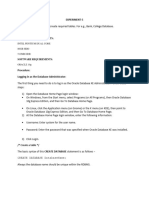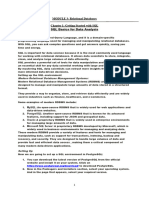Blogs Technet Com B Mdegre Archive 2009-09-04 SQL Server How
Blogs Technet Com B Mdegre Archive 2009-09-04 SQL Server How
Uploaded by
Bhupendra Singh TanwarCopyright:
Available Formats
Blogs Technet Com B Mdegre Archive 2009-09-04 SQL Server How
Blogs Technet Com B Mdegre Archive 2009-09-04 SQL Server How
Uploaded by
Bhupendra Singh TanwarOriginal Title
Copyright
Available Formats
Share this document
Did you find this document useful?
Is this content inappropriate?
Copyright:
Available Formats
Blogs Technet Com B Mdegre Archive 2009-09-04 SQL Server How
Blogs Technet Com B Mdegre Archive 2009-09-04 SQL Server How
Uploaded by
Bhupendra Singh TanwarCopyright:
Available Formats
Sign in
TechNet Blogs > Microsoft SQL Server > How to insert data from one table to another table
Common Tasks
Blog Home Email Blog Author About RSS for comments RSS for posts
How to insert data from one table to another table
Degremont Michel 4 Sep 2009 3:45 PM
RATE THIS
SQL globe readers
How to insert data from one table to another table by using SQL Server There are various ways to insert data from one table to another table. I will present you the most efficently. Using INSERT INTO This method is used when the table is already existing in the database. The datas will be inserted into this table from another table. You don't have to list the columns If columns listed in insert clause and select clause are egual and with the same type. But to avoid any mistake, I recommand you to list each column. You can create an Insert From query, when you specify: - The database table to copy rows to (the destination table). - The table or tables to copy rows from (the source table). - The source table or tables become part of a subquery. - Sort order, if you want to copy the rows in a particular order. - Group By options, if you want to copy only summary information. Sample:
Search
Search TechNet with Bing Search this blog Search all blogs
Recent Posts
Command sp_cycle_agent_errorlog is failing Unable to install SCOM 2012 Reporting Services How configure correctly AlwaysOn readable secondary replica for applicationIntent How to create a dependency between
Are you a developer? Try out the HTML to PDF API
open in browser PRO version
pdfcrowd.com
CREATE TABLE [tempdb].[dbo].[myTempTable]( [backup_set_id] [int] NOT NULL, [name] [nvarchar](128) NOT NULL, [filegroup_id] [int] NOT NULL, [filegroup_guid] [uniqueidentifier] NULL, [type] [char](2) NOT NULL, [type_desc] [nvarchar](60) NOT NULL, [is_default] [bit] NOT NULL, [is_readonly] [bit] NOT NULL, [log_filegroup_guid] [uniqueidentifier] NULL ) ON [PRIMARY] GO INSERT INTO [tempdb].[dbo].[myTempTable] ( [backup_set_id] ,[name] ,[filegroup_id] ,[filegroup_guid] ,[type] ,[type_desc] ,[is_default] ,[is_readonly] ,[log_filegroup_guid]) SELECT [backup_set_id] ,[name] ,[filegroup_id] ,[filegroup_guid] ,[type] ,[type_desc] ,[is_default] ,[is_readonly] ,[log_filegroup_guid] FROM [msdb].[dbo].[backupfilegroup] GO SELECT * FROM [tempdb].[dbo].[myTempTable] ; GO DROP TABLE [tempdb].[dbo].[myTempTable] ;
How to create a dependency between two or more Availability Groups AlwaysOn warning: The current WSFC cluster quorum vote configuration is not recommended for this availablity group
Tags
Alw aysOn Av ailability Group
AMO
Analysis Services
Cluster
TIP
Connectiv ity
DBA
DC High Availability
Installation
MSCS Performance
Kerberos
Management Studio Migration
Powershell
Replication
Security
SQL
Server
SQL Serv er Clustering
SQL Server High Availability
SSMS
SSAS
SSIS
T-SQL
Windlows
Cluster
Archives
September 2013 (1) May 2013 (1) April 2013 (2) March 2013 (2) December 2012 (1)
Inserting Rows by Using SELECT INTO
open in browser PRO version
Are you a developer? Try out the HTML to PDF API
pdfcrowd.com
With this method you don't need to create the table before the insert. Table will be created when data from one table will be inserted from another table. This new table will be created with same data types as selected columns. SELECT INTO can be used to combine data from several tables or views into one table. It can also be used to create a new table that contains data selected from a linked server. Sample:
December 2012 (1) October 2012 (1) September 2012 (1) August 2012 (1) June 2012 (3) April 2012 (6) March 2012 (6) February 2012 (9) January 2012 (3) December 2011 (3) November 2011 (6) October 2011 (7) September 2011 (6) July 2011 (9) June 2011 (6) March 2011 (3) January 2011 (4) December 2010 (3) November 2010 (3) September 2010 (6) August 2010 (6) July 2010 (3) June 2010 (3) May 2010 (2) March 2010 (4) February 2010 (4) January 2010 (2) December 2009 (4) November 2009 (2) October 2009 (4) September 2009 (4) August 2009 (4) July 2009 (4)
SELECT [backup_set_id] ,[name] ,[filegroup_id] ,[filegroup_guid] ,[type] ,[type_desc] ,[is_default] ,[is_readonly] ,[log_filegroup_guid] INTO [tempdb].[dbo].[myTempTable] FROM [msdb].[dbo].[backupfilegroup] GO SELECT * FROM [tempdb].[dbo].[myTempTable] ; GO DROP TABLE [tempdb].[dbo].[myTempTable] ;
SELECT INTO is non-logged operation when the db is in bulk_logged mode.You can use BCP too... Read the the following article for more info. http://support.microsoft.com/?scid=kb;en-us;Q272093 INSERT INTO is recommended over SELECT INTO since the later requires more lock resources.
Don't ask you which one is the best. You have to keep in mine that this both solution are different and adapted to a specific value.
Michel Degremont | Microsoft EMEA
open in browser PRO version
Are you a developer? Try out the HTML to PDF API
pdfcrowd.com
Product Support Services Developer - SQL Server Core Engineer |
SQL Server, T-SQL
Leave a Comment
Name
Comment
Post
Comments
Torsten Hi, how do you specify the sort order, as mentioned "- Sort order, if you want to copy the rows in a particular order." INSERT INTO [tempdb].[dbo].[myTempTable] ( ..) SELECT ... FROM [msdb].[dbo].[backupfilegroup] ORDER BY [column1] Won't change anything. 7 Feb 2013 7:47 AM
open in browser PRO version
Are you a developer? Try out the HTML to PDF API
pdfcrowd.com
I need this, because my table has foreign key relations on itself (col1=col2). so some rows need to be inserted before others.
Degremont Michel Hi,
20 Mar 2013 4:40 AM
you just have to add the ORDER BY clause after SELECT * FROM [tempdb].[dbo].[myTempTable] ; and you can chose by with columns. Let me know if you need any help.
2013 Microsoft Corporation. Term s of Use
Tradem arks
Privacy & Cookies
5.6.426.415
open in browser PRO version
Are you a developer? Try out the HTML to PDF API
pdfcrowd.com
You might also like
- C Session 11Document48 pagesC Session 11eshamuNo ratings yet
- Tools-SQL Assistant OverviewDocument5 pagesTools-SQL Assistant OverviewNav4ScribdNo ratings yet
- Connecting To SQL Server Using SSMSDocument18 pagesConnecting To SQL Server Using SSMSAravindNo ratings yet
- Teradata SQL AssistantDocument9 pagesTeradata SQL AssistantkishoreparasaNo ratings yet
- How To Start SQL Assistant Using Batch Mode or Using Command Prompt?Document9 pagesHow To Start SQL Assistant Using Batch Mode or Using Command Prompt?abreddy2003No ratings yet
- How To Start SQL Assistant Using Batch Mode or Using Command Prompt?Document9 pagesHow To Start SQL Assistant Using Batch Mode or Using Command Prompt?abreddy2003No ratings yet
- S07 Create TablesDocument30 pagesS07 Create Tablesmartin duyNo ratings yet
- SQLDocument86 pagesSQLtbijleNo ratings yet
- Sqlserver2005 FeaturesDocument9 pagesSqlserver2005 FeaturesSwaraj KumarNo ratings yet
- SQL ServerDocument163 pagesSQL Servershilpabach100% (1)
- KUDVENKAT SQL SERVER TRANSCRIPT-Part1Document125 pagesKUDVENKAT SQL SERVER TRANSCRIPT-Part1Arnab DeyNo ratings yet
- DBMS Experimentdbms-5Document4 pagesDBMS Experimentdbms-5Deepak SwamiNo ratings yet
- Assignment #3: Department of Computer Science Spring Semester 2016Document25 pagesAssignment #3: Department of Computer Science Spring Semester 2016Neha ArifNo ratings yet
- SQL BasicsDocument34 pagesSQL BasicsOpeyemi Adenugba-OdugbesanNo ratings yet
- Lab Session 1-3Document13 pagesLab Session 1-3nigusNo ratings yet
- Module 3Document76 pagesModule 3Pranjali KathaitNo ratings yet
- Database Development Using SQL: Department of Information TechnologyDocument38 pagesDatabase Development Using SQL: Department of Information Technologyfreaking2012No ratings yet
- DBreeze Documentation ActualDocument133 pagesDBreeze Documentation ActualJackson HayesNo ratings yet
- Delphi Getting Started With SQL Part 1 PDFDocument6 pagesDelphi Getting Started With SQL Part 1 PDFmicroserverNo ratings yet
- SQL QueryDocument9 pagesSQL QuerynnandhaNo ratings yet
- Microsoft SQL ServerDocument7 pagesMicrosoft SQL ServerAnand sharmaNo ratings yet
- InterviewDocument222 pagesInterviewAditya Narayahn BiswalNo ratings yet
- Dbms Practical PrintDocument10 pagesDbms Practical PrintKushNo ratings yet
- SQLandAdvancedSQL by ExamplesDocument68 pagesSQLandAdvancedSQL by Exampleschiran100% (4)
- ADO.netDocument64 pagesADO.netKumar AnupamNo ratings yet
- What Is Major Difference Between SQL and PLSQL?Document70 pagesWhat Is Major Difference Between SQL and PLSQL?Ajay GuptaNo ratings yet
- DBA Session 3 SQLDocument63 pagesDBA Session 3 SQLDaniTesfayNo ratings yet
- SQL Server TutorialDocument25 pagesSQL Server TutorialDhiren PatelNo ratings yet
- LoopDocument5 pagesLoopJayaprakash JNo ratings yet
- Database Management System MySQLDocument71 pagesDatabase Management System MySQLhazelyildiz18No ratings yet
- SQL Server Interview QuestionsDocument28 pagesSQL Server Interview QuestionshardhikasreeNo ratings yet
- SQL GetDocument213 pagesSQL GetMano Haran100% (1)
- Writing SQL Queries - Let's Start With The BasicsDocument6 pagesWriting SQL Queries - Let's Start With The BasicsHevant BhojaramNo ratings yet
- New Microsoft Office Power Point PresentationDocument59 pagesNew Microsoft Office Power Point PresentationalogargNo ratings yet
- SQL Server 2005 Programmability Enhancements - Common Table ExpressionsDocument7 pagesSQL Server 2005 Programmability Enhancements - Common Table ExpressionsMohammed SajidNo ratings yet
- SQL Book-1Document57 pagesSQL Book-1Ron ParekhNo ratings yet
- Writing SQL QueriesDocument15 pagesWriting SQL QueriesKarthikeyanNo ratings yet
- Writing SQL Queries BsicsDocument9 pagesWriting SQL Queries BsicsAnirban BaralNo ratings yet
- (Structured Query Language) : SundiesDocument49 pages(Structured Query Language) : SundiesDon Sunny100% (1)
- S S O O S: Description Key FieldsDocument6 pagesS S O O S: Description Key FieldsRofen GaleyNo ratings yet
- Beginners SQL PlusDocument14 pagesBeginners SQL Plussalamanda1969No ratings yet
- SQL ExampleDocument11 pagesSQL ExampleAravind RadhakrishnanNo ratings yet
- Sql2Excel 1.5Document6 pagesSql2Excel 1.5nathan708No ratings yet
- Simple Queries in SQLDocument26 pagesSimple Queries in SQLAryan Dev0% (1)
- SQL Notes PDFDocument42 pagesSQL Notes PDFTanmay SahaNo ratings yet
- Like Keyword MSAccessDocument8 pagesLike Keyword MSAccessapi-3841500No ratings yet
- IK3B - 12 - Kholan Mustaqim - Jobsheet 2 - CTE (Common Table Expression) Dan Pivot TableDocument18 pagesIK3B - 12 - Kholan Mustaqim - Jobsheet 2 - CTE (Common Table Expression) Dan Pivot TableArdhi YahyaNo ratings yet
- SABA - T24 Admin Induction Training v1.0Document31 pagesSABA - T24 Admin Induction Training v1.0Mohamed HamdyNo ratings yet
- SQL Server ManagementDocument185 pagesSQL Server ManagementnalinagcNo ratings yet
- SQL Lab Manual Guide MaterialsDocument15 pagesSQL Lab Manual Guide MaterialsBirhanu WorkuNo ratings yet
- SQL Basic 12-28-11Document4 pagesSQL Basic 12-28-11bigmanharrisNo ratings yet
- DBMS FileDocument31 pagesDBMS FilemglotovNo ratings yet
- SQL Server T-SQLDocument30 pagesSQL Server T-SQLAdrian Magpantay0% (1)
- Ibm DB2Document3 pagesIbm DB2anon-129431100% (2)
- LAB # 01 Introduction To SQL: ObjectiveDocument13 pagesLAB # 01 Introduction To SQL: ObjectivezulfiqarNo ratings yet
- 5.3 SQLDocument29 pages5.3 SQLBLADE LEMONNo ratings yet
- Three Days Workshop On SQL Server 2005: Presented byDocument31 pagesThree Days Workshop On SQL Server 2005: Presented bykishornavalNo ratings yet
- Interview QuestionsDocument19 pagesInterview Questionsjayrathod03100% (1)
- DB2 11.1 for LUW: SQL Basic Training for Application DevelopersFrom EverandDB2 11.1 for LUW: SQL Basic Training for Application DevelopersNo ratings yet
- PRESENTED BY Ankita Seth Depertment Cse Class Roll 016 REGISTRATION NO 092360110006 ROLL NO 09236001031Document19 pagesPRESENTED BY Ankita Seth Depertment Cse Class Roll 016 REGISTRATION NO 092360110006 ROLL NO 09236001031Ankita SethNo ratings yet
- Circular Buffering On TMS320C6000: Dipa Rao DSP West ApplicationsDocument17 pagesCircular Buffering On TMS320C6000: Dipa Rao DSP West ApplicationsSuba LakshmiNo ratings yet
- 3 3 28addingandsubtractingpolynomials2 PDFDocument3 pages3 3 28addingandsubtractingpolynomials2 PDFOtilia CordovaNo ratings yet
- Abx Pentra400 ManualDocument24 pagesAbx Pentra400 ManualNurNo ratings yet
- Product Owner - Vaibhav - ResumeDocument3 pagesProduct Owner - Vaibhav - ResumeVaibhav Kharpate100% (2)
- Oracle GoldenGateDocument44 pagesOracle GoldenGateGovinda GallaNo ratings yet
- Jagannatha Hora: Free Vedic Astrology SoftwareDocument2 pagesJagannatha Hora: Free Vedic Astrology SoftwaremoNo ratings yet
- Algorithms: CSE 202 - Additional Problems On Approximation AlgorithmsDocument2 pagesAlgorithms: CSE 202 - Additional Problems On Approximation AlgorithmsballechaseNo ratings yet
- Unicommerce e BrochureDocument16 pagesUnicommerce e BrochureNeeraj SharmaNo ratings yet
- TexxtDocument12 pagesTexxtgalichaNo ratings yet
- Digital Marketing Training Syllabus ICDL - AcademySIDDocument7 pagesDigital Marketing Training Syllabus ICDL - AcademySIDAcademySIDNo ratings yet
- VB Script GCDocument77 pagesVB Script GCdharbabNo ratings yet
- 8968-Article Text-33679-1-10-20231010Document16 pages8968-Article Text-33679-1-10-20231010zulhijah wulandariNo ratings yet
- How To Install Logstash With Kibana Interface On RHEL - Above The CloudsDocument17 pagesHow To Install Logstash With Kibana Interface On RHEL - Above The CloudsVinod GuptaNo ratings yet
- Multiple Linear RegressionDocument14 pagesMultiple Linear RegressionNamdev100% (1)
- d2b Emails To Create AuditDocument4 pagesd2b Emails To Create Auditapi-290587833No ratings yet
- 20bcs0003 Oop Lab Fat ExamDocument10 pages20bcs0003 Oop Lab Fat ExamNithish .PNo ratings yet
- Driver TV Tuner Gadmei 3810eDocument2 pagesDriver TV Tuner Gadmei 3810eAl-Shahibul RahmanMSSNo ratings yet
- All The BAPI ListDocument189 pagesAll The BAPI Listchandrashekhar khasnisNo ratings yet
- Ross-Tech: Ross-Tech-Tip - VW/Audi Airbag Module CodingDocument1 pageRoss-Tech: Ross-Tech-Tip - VW/Audi Airbag Module Codingmps125No ratings yet
- Project and Change Management Lecture 1Document34 pagesProject and Change Management Lecture 1tanto_deep_15No ratings yet
- Lecture 3 Verifying Correctness of AlgorithmDocument125 pagesLecture 3 Verifying Correctness of AlgorithmIbrahim ChoudaryNo ratings yet
- Design, Implementation, and Evaluation of An XG-PON Module For ns-3 Network SimulatorDocument15 pagesDesign, Implementation, and Evaluation of An XG-PON Module For ns-3 Network SimulatordwiaryantaNo ratings yet
- Template Pipeline KUM KUR Cluster Tangerang Batu Ceper 03112023Document16 pagesTemplate Pipeline KUM KUR Cluster Tangerang Batu Ceper 03112023iikmawarti78No ratings yet
- Overview: Library Is Regarded As The Brain of Any Institute Many Institutes Understand The Importance of The LibraryDocument1 pageOverview: Library Is Regarded As The Brain of Any Institute Many Institutes Understand The Importance of The LibraryMhaeLimenNo ratings yet
- Chilli Fire Hotspot Router Installation Guide MikrotikDocument8 pagesChilli Fire Hotspot Router Installation Guide MikrotikKang DalikinNo ratings yet
- Game CrashDocument107 pagesGame Crashangel pardo muñozNo ratings yet
- ANSYS Multibody AnalysisDocument74 pagesANSYS Multibody AnalysisPaul NewmanNo ratings yet
- New Microsoft Word DocumentDocument5 pagesNew Microsoft Word DocumentRajnish Bihari ShrivastavaNo ratings yet
- Java - OOPsDocument41 pagesJava - OOPskasimNo ratings yet

























































































